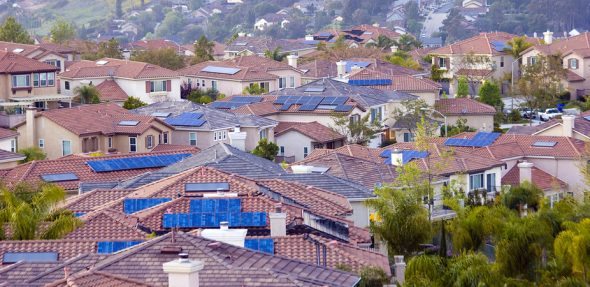What would happen if every Australian household installed solar PV on their rooftops? That’s the hypothetical question a new study has set out to answer, with the main aim of proving a solar point (while rattling a few cages along the way): that solar power is a viable solution to Australia’s energy challenges and has the potential to dramatically change the nation’s energy landscape.
The study, conducted by solar provider Energy Matters using government data, found that if every suitable rooftop in Australia was turned into a solar power station, the amount of energy generated would supply more than 134.8 per cent of the country’s residential electricity needs, and would drive down power prices from an average of 30c per kilowatt-hour to 7c/kWh.
According to Energy Matters, there is just under 400 square kilometres of available roof space on residential roof tops in Australia that could accommodate solar panels – equal to the size of inner Melbourne. By the company’s calculations, each one of the suitable houses could theoretically hold an 8kW, 32-panel solar power system. The cost for each system at the current market rate would be less than $14,000.
These houses would then generate 36kWh per day; and with the average household currently consuming 18kWh per day, the excess electricity would earn the household between $2100 and $3,200 per year. This way, the study estimates each household’s solar system would be paid off in between four and six years.
And then there is what Energy Matters describes as the “knock on effect” to factor in, with energy prices and CO2 emissions reduced dramatically, and a huge boon in green jobs.
As for the cost of the installation, the study finds this would represent 8 per cent of Australia’s yearly GDP, or 0.4 per cent per year when amortised over 20 years. This compares to the $15 billion Australia currently spends on electricity each year, which amounts to 1 per cent of it GDP.
What would happen to Australia’s current electricity production facilities under this scenario? “There would be almost no need for base load power stations on a sunny day,” said Brass. “Australia could close down most of its coal-driven power stations overnight, except for those in heavy industrial areas. Under-utilised gas fired peaking plants, which are already in existence, would be called upon to generate Australia’s night time and cloudy day electricity needs. Shutting down Australia’s coal power stations alone would mean our emissions targets would be met almost immediately.”
It all sounds pretty sensational, but according to Energy Matters, who released the results of the study today, the figures it has turned up are “extremely conservative” (the company’s calculations show solar can supply 134 per cent of Australia’s residential needs, but it says the actual figure would be much higher), and its hypothetical scenario of a rooftop solar-powered Australia “could easily become a reality.”
“Our vision is not too dissimilar to Bill Gates’, who predicted every household would have a computer,” says Energy Matters’ Nick Brass. “People at first scoffed at this vision, but the advent of the affordable personal computer changed the world. Energy Matters’ grand plan is to help convert every suitable rooftop in Australia into a solar power station.”
“The idea is for the eligible houses to produce more electricity than they need with the excess supply fed back into the grid in order to power Australia’s residential and non-residential needs,” said Brass. “Further calculations we performed indicate the amount of electricity generated would supply 38.8% of Australia’s total electricity requirements (inclusive of all residential, industry, commercial services, metal production and mining).”










